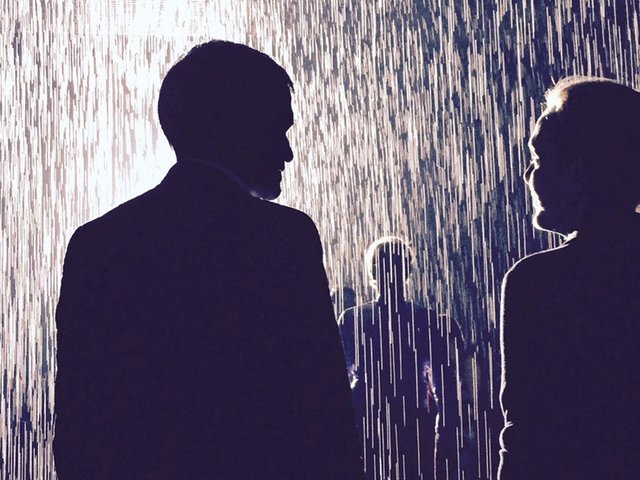China’s copycat culture is equal parts famous and infamous. Blatant imitation was an integral part of the international trade that launched China’s emergence on the world stage three decades ago, and, despite improvements, it remains a problem for the Chinese government, international and local companies—and artists. Yet out of south China’s rapid development and massive-scale manufacturing, a strange space between copying, appropriation, hacking and original creation has emerged, known as shanzhai.
Although it is most visible in design and technology, shanzhai has seeped into art, music and other areas of cultural production in China. Explicit copying persists, from the Van Goghs and Yue Minjuns churned out by painters in Dafen and other imitation painting centres to unauthorised versions of Random International’s Rain Room, including a fake that opened in Chengdu earlier this month.
Shanzhai starts with slight tweaks, such as those seen in Karamay’s Anish Kapoor Cloud Gate derivative, which the local government defended as being different thanks to the addition of lasers and smaller rocks; Bund Stars Garden, which offered a musical light-show rendition of Rain Room in a Shanghai basement; and a re-creation of Yayoi Kusama’s Sticker Room with pastel Post-It notes. Elsewh ere on the spectrum, Chinese contemporary artists, like their peers across the world, often appropriate images and other works of art.
Directly translated, shanzhai means “a remote mountain village”, implying “a group of people living in the mountain and taking it as theirs without governmental rules, who are really independent and fight for themselves”, says Sophia Lin, the founder of Make+, a Shanghai-based organisation that focuses on the intersection between hacking and art. “Shanzhai used to be a bad word… but I feel as though it is quite different now. People ‘shanzhai’ to appropriate trends or new technology, but they add new elements to the original or deconstruct it with new methods, making it more accessible to the public,” she says. “In hacker culture, shanzhai is the stepping stone to an original product: one learns from the old, takes it apart and makes a new one. But really, the same goes for everything: we study from the master, make it our own and produce a work of our own.”
“In China, imitating a master was considered part of the learning process, but also an expression of respect; only later could one develop a personal style,” says Xiang Liping, the head of exhibitions at Shanghai’s Power Station of Art, who organised Copyleft, a show about appropriation and shanzhai in Chinese art, last year.

“Art insiders and outsiders all oppose fake or pirated art. People universally believe that art should be authentic,” Xiang says. “Most Chinese believe that art should be something that will be passed on for ages, and should not be taken as casually as transient commercial goods like fashion and technological products.” She divides shanzhai into universally loathed cheap knock-offs, painstaking reproductions (such as the imitation European towns dotting Chinese suburbs) and innovative, affectionate reinterpretations. The creative potential of the third category “is why I advocate a more neutral view of shanzhai”, Xiang says.
Luisa Mengoni, who is leading the creation of the V&A Gallery in the planned Shekou Design Museum in Shenzhen, says: “The term shanzhai has traditionally been used in quite a derogatory way to refer to counterfeit goods and cheap imitations of established brands.” The term was first adopted in Hong Kong a few decades ago to refer to cheap household wares or reproductions, but re-emerged in Shenzhen in 2000, she says. Although the association with fakes endures, it “cannot be considered the only meaning of the word. ‘Shanzhai’ also refers to a wider system of production in which small and often unknown companies have been able to develop, produce and distribute customised products responding to specific market requirements that are not covered by leading brands,” Mengoni says. Shanzhai is credited with making smartphones accessible to the Chinese and global poor, for example.
Mengoni says that initiatives such as David Li’s Shenzhen Open Innovation Lab suggest a “‘new shanzhai’, an open ecosystem of manufacturing in which innovation has already taken place in unexpected forms and that is now becoming an attractor for individuals, companies, makers and start-ups that are developing new ideas and projects”.
Qi Yongfeng, a professor of cultural structures at China Communications University in Beijing, rejects the idea that China’s copycat culture is unique. “Only China has the term, but lots of countries had the same conditions of copying when developing,” Qi says. “China is special because it is so big, so it’s harder to control. But it’s not traditional to Chinese culture; it’s a phenomenon.”
Qi adds that Chinese people’s understanding of the law is unclear, which results in much of the copying—and Chinese law can be equally befuddling for international artists showing in China.



